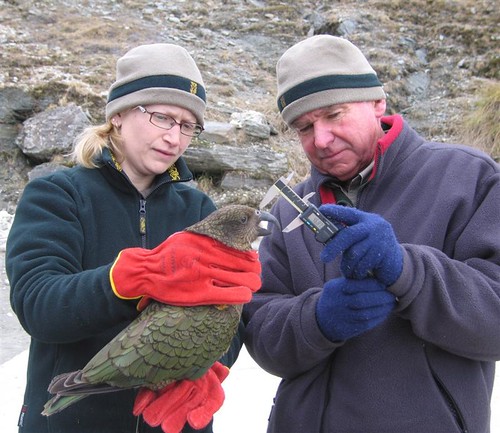 Flo Gaud and Stu Thorne measure the beak of a kea as part of a Department of Conservation monitoring programme around Treble Cone skifield. Kea around Treble Cone skifield, near Wanaka, have been the subject of a recent Department of Conservation study into the habits of the inquisitive and endangered native alpine parrot.
Flo Gaud and Stu Thorne measure the beak of a kea as part of a Department of Conservation monitoring programme around Treble Cone skifield. Kea around Treble Cone skifield, near Wanaka, have been the subject of a recent Department of Conservation study into the habits of the inquisitive and endangered native alpine parrot.
A drop in kea population numbers has left Doc Wanaka biodiversity manager Stu Thorne "slightly" concerned.
The Doc study was carried out to collect information about kea in the area and also to find whether the native parrots were healthy. Further monitoring would be carried out to try to identify the cause of their decline, Mr Thorne said.
Sixteen kea were captured, measured, weighed and physically checked. They were then banded for identification and released.
Concerns about the health status of some kea populations around the South Island - specifically in the Mt Cook/Aoraki area where some of the native parrots were found to have lead poisoning during summer - has worried Doc monitoring staff.
Aerial 1080 poison drops in South Westland and other regions have been blamed for a decline in kea numbers. Seven kea died after ingesting 1080 around the Fox and Franz Josef areas, last year.
However, Mr Thorne said none of those issues had affected the kea populations in the alpine regions of the Matukituki Valley. There had been no aerial drops of 1080 in their habitat around Wanaka, he said.
Seven kea were given blood tests during the recent monitoring programme and the results all indicated "low to very low" levels of lead.
Mr Thorne ruled out contact with people visiting the skifield area as a possible cause of a decline in kea numbers.
"There's probably not any one single cause contributing to a decline, but I do think a growth in predator numbers could be significant."
The presence of stoats in the alpine areas and "vulnerable" kea nesting habitats could be having an effect, he said.